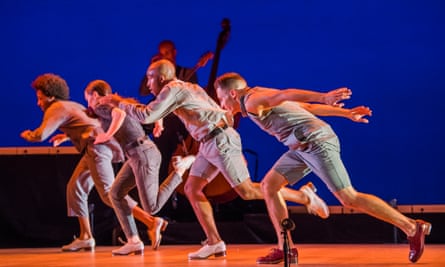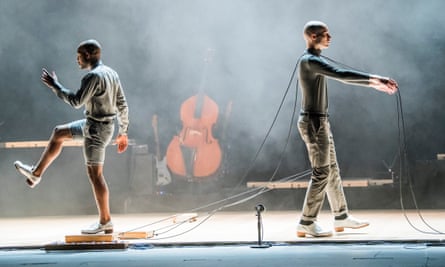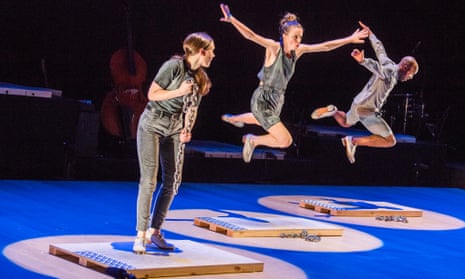Michelle Dorrance has been acclaimed as the new voice and heart of American tap, an exuberantly expressive dancer and inquisitive choreographer who’s passionate about bringing tap to a new audience. That Dorrance is a woman is in itself significant, given how much of the form’s long history has been dominated by men.
Tap was born out of the slave and immigrant communities of the US – a mongrel form, like most world dances, which fused the close-knit footwork of the Irish jig, the percussive sounds of Lancashire clogging and the syncopated dance rhythms of Africa. It also came to acquire a quintessentially urban edge, from the street-corner dance-offs that became popular during the 19th century. Dancers would perform on makeshift wooden platforms, competing to produce the sharpest, most original sounds while their “judges” sat underneath, ostensibly to listen more closely, but also perhaps to shelter from the aggressive support of rival gangs.
Macho in culture, these tap competitions were a forerunner of the B-boy battles that became so key to the hip-hop scene in the late 1960s. There’s another historical similarity between the forms, too, in the way both have fractured into different styles, taking on the accents of other dance and music.
The inspiration of those original “rhythm tappers” was never lost from tap as it moved from the street to the stage. Its classic exponents, mostly black, mostly male – such as Bill “Bojangles” Robinson and Charles “Honi” Coles – remained at the heart of it. They were celebrated for their ability to improvise rhythms and melodies with their feet while maintaining a cool, self-contained stillness in the rest of their bodies.
During much of the 20th century, rhythm tap was overtaken by the more spectacular and white-dominated forms of show tap. It was channeled into the chorus lines of big Broadway musicals, in which rows of strictly drilled dancers produced an exhilarating roar of sound with the shuffling and clacking of their metal-tapped shoes. Tap also acquired different kinds of virtuosity as stars such as Fred Astaire brought a ballroom finesse, fluidity and lightness to the genre’s grounded rhythms, or Gene Kelly spun it around with acrobatic stunts and balletic buoyancy.

In the 1990s, however, rhythm tap underwent a renaissance – and a reinvention. Tap Dogs, a semi-ironic and sexily ripped production created by Dein Perry, toured the world with a cast of performers dressed like construction workers, who tapped out hard industrial riffs on a set resembling a building site. Even more radical was the young dancer Savion Glover, whose Tony award-winning Bring in Da Noise Bring in Da Funk combined rhythm tap and hip-hop in its dance history of black America.
Glover, with his dreadlocks and baggy jeans was, and still is, a tapping genius. His footwork is so fast and subtle, his musicality so inventive, that he can hold an audience spellbound by the mathematical magic of his rhythms. He’s performed to every kind of accompaniment, from John Coltrane to Béla Bartók, but latterly he’s refined his performances into Zen states of improvisation, playing rarified games with sound that are interestingly close in spirit to Israel Galván, the puckish maverick of modern flamenco.
As Glover has stripped his performances down, Dorrance has arrived with her own invitingly theatrical approach. She brings a sensibility and a skill set from contemporary dance, choreographing not only for the feet but for the legs, arms and torso, so her dancers throw out an expressive variety of shapes as they tap. She’s distinctive, too, in the way she exploits her dancers’ individual qualities while also exploring the possibilities of duets, ensembles and floor patterns.
In ETM: Double Down, which opened in London this week, Dorrance also channels the world of electronic dance music. During much of the show, she and her seven dancers perform on electronic tap boards that have been devised by company member Nicholas van Young to function like electronic drum pads. With every percussive tap, the dancers can trigger computerised notes, adding a layer of melody not only to their own footwork but to the playing of the acoustic musicians – drummer, keyboard and singer – who are live on stage (and at moments have their own music sampled into echoing loops of sound).
Tap dancers are always their own musicians, with a whole percussion section of rat-a-tat beats, growls and glissando slides in their feet. Here, though, Dorrance and Van Young have created a playground of sonic fun. During one section, seven dancers are lined up on drum pads to tap out a tune, which they pass backwards and forwards between themselves. As the music accelerates, the dancers squat, grimace and make jokey cartoon poses as they catch the melody, until together they form a giant animated keyboard.

At another moment, half of the company unite to make a background chorus of sound while a soloist taps out a virtuoso aria centre stage. In others, a battle of rhythm and noise ensues as some of the company dance while others take to playing the drums.
Dorrance and Van Young don’t much bother with structure in ETM, simply rattling through their best ideas, and parts of this 95-minute show do feel dislocated and diffuse. Most of the time, though, the evening’s energy is sustained by the seductive virtuosity of its performers. Dorrance has a gregarious, tomboy charm – all flying elbows and knees, lickety-splits and skids; but dancing in duet she hits other emotional notes. With the lanky, bald and dreamily introverted Warren Craft she goes into a slow zone of improvisation; with the stocky, bearded Van Young she’s larky and strong; and with Ephrat “Bounce” Asherie – the breakdancing B-girl of the group – she engages in joyous battle, her tapping feet flying in and out of Asherie’s spinning, windmilling and top-rocking orbit.
There’s an irresistible collective spirit to this company, too. When they’re all performing together, the stage becomes clamorous with cross rhythms, counterpointed phrases and laughter. The rocking finale, in which all eight dancers are joined by all three musicians, has the audience on its feet. While I’m not yet convinced that Dorrance has hit her stride as a choreographer, she’s plugged into something very fresh and free with ETM. This is a show that will surely do for today’s tap what Bring in Da’ Noise and Tap Dogs did for previous generations.
- Dorrance Dance – ETM: Double Down is at Sadler’s Wells, London, until 15 July. Box office: 020-7863 3000

Comments (…)
Sign in or create your Guardian account to join the discussion